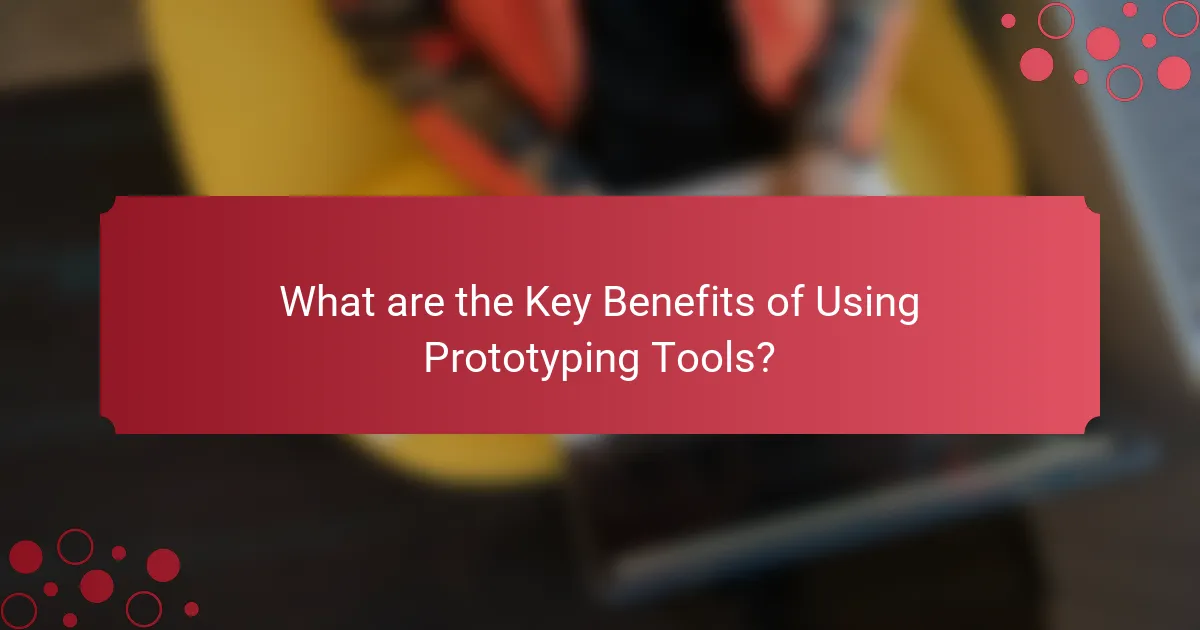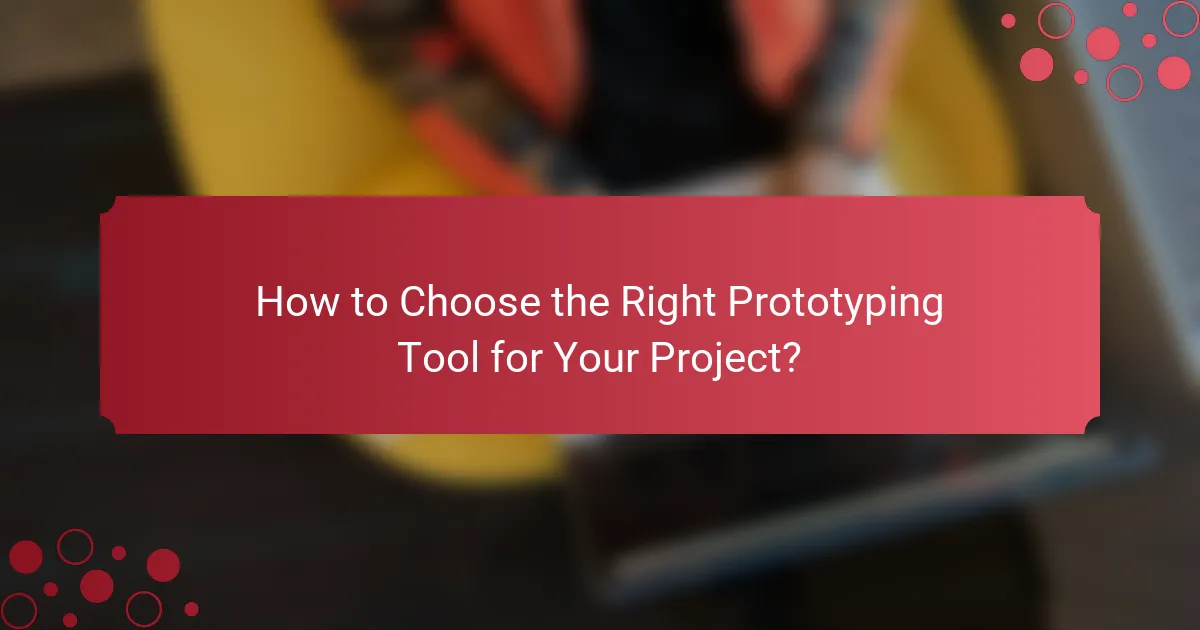Prototyping tools are essential for web projects, with leading options including Figma, Adobe XD, Sketch, InVision, and Axure RP. Each tool offers distinct features, such as real-time collaboration in Figma, voice prototyping in Adobe XD, and a user-friendly interface in Sketch. These tools enhance stakeholder communication, facilitate rapid iteration based on user feedback, and help identify usability issues early in the development process. Key considerations for selecting a prototyping tool include project requirements, team skill levels, software integration, mobile responsiveness, and available design resources. Understanding these aspects can significantly streamline the design process and improve project outcomes.

What are the Top Prototyping Tools for Web Projects?
Figma, Adobe XD, Sketch, InVision, and Axure RP are the top prototyping tools for web projects. Figma allows real-time collaboration and is web-based. Adobe XD integrates well with other Adobe products and offers voice prototyping. Sketch is known for its user-friendly interface and extensive plugin ecosystem. InVision provides a powerful platform for interactive prototypes and user testing. Axure RP supports complex interactions and detailed wireframing. These tools are widely used in the industry for their unique features and capabilities.
How do these prototyping tools enhance the web development process?
Prototyping tools enhance the web development process by streamlining design and improving collaboration. They allow developers to create interactive wireframes and mockups quickly. This speeds up the feedback cycle with stakeholders. Enhanced visualization helps in understanding user experience before coding begins. Prototyping tools also reduce costly changes during later development stages. They support iterative design, enabling continuous improvement based on user testing. Additionally, these tools often integrate with other development software, promoting seamless workflows. Overall, they lead to a more efficient and user-centered web development process.
What features should you look for in a prototyping tool?
A prototyping tool should have collaboration features, ease of use, and versatility. Collaboration features allow multiple users to work together in real-time. This enhances communication and feedback during the design process. Ease of use ensures that team members can quickly learn and navigate the tool. A user-friendly interface reduces onboarding time. Versatility enables the tool to support various types of prototypes, from low-fidelity wireframes to high-fidelity interactive models. Additionally, integration capabilities with design and development tools streamline workflows. These features collectively enhance the efficiency and effectiveness of the prototyping process.
How do different prototyping tools compare in functionality?
Different prototyping tools vary significantly in functionality. Tools like Figma offer collaborative features, enabling real-time editing and feedback. Adobe XD focuses on design integration with other Adobe products. Axure provides advanced interactivity and conditional logic for complex prototypes. InVision excels in user testing and feedback collection. Sketch is known for its vector-based design capabilities and plugin ecosystem. Each tool serves specific project needs, influencing team workflows and project outcomes.
Why are prototyping tools essential for web projects?
Prototyping tools are essential for web projects because they facilitate design visualization and user experience testing. These tools allow designers to create interactive mockups that simulate the final product. This process helps identify usability issues early in the development cycle. According to a study by the Nielsen Norman Group, prototyping can reduce development time by up to 50%. Furthermore, prototyping tools enhance collaboration among team members and stakeholders. They provide a clear reference point for discussions and feedback. This leads to more informed decision-making and ultimately a better final product.
What role do prototyping tools play in user experience design?
Prototyping tools are essential in user experience design as they facilitate the creation of interactive models of a product. These tools allow designers to visualize concepts and test functionality before full-scale development. By using prototyping tools, teams can gather user feedback early in the design process. This iterative approach helps identify usability issues and refine design elements effectively. Research indicates that early prototyping can reduce development costs by up to 50%. Moreover, prototyping tools enhance collaboration among stakeholders by providing a tangible representation of ideas. This leads to improved communication and alignment on project goals.
How can prototyping tools facilitate collaboration among teams?
Prototyping tools facilitate collaboration among teams by providing a shared platform for design and feedback. These tools enable real-time collaboration, allowing team members to contribute simultaneously. They support visual communication through interactive prototypes, which help convey ideas effectively. Prototyping tools also streamline the feedback process, making it easier to gather input from stakeholders. Features like commenting and version control enhance clarity and organization. According to a study by the Nielsen Norman Group, using prototyping tools can reduce design errors by up to 50%. This efficiency fosters a more cohesive team environment and accelerates project timelines.

What are the Key Benefits of Using Prototyping Tools?
Prototyping tools offer several key benefits for web projects. They enhance communication among stakeholders by providing visual representations of ideas. This reduces misunderstandings and aligns expectations early in the development process. Prototyping tools also enable rapid iteration. Designers can quickly modify prototypes based on feedback, leading to improved user experiences. Additionally, these tools help in identifying usability issues before full-scale development. A study by the Nielsen Norman Group shows that early user testing can reduce overall project costs by up to 50%. Overall, prototyping tools streamline the design process and foster collaboration.
How do prototyping tools save time and resources?
Prototyping tools save time and resources by enabling rapid design iterations. These tools allow designers to create and modify prototypes quickly. This reduces the time spent on revisions during development. Additionally, prototyping tools facilitate early user feedback. Gathering feedback at an early stage minimizes costly changes later in the project. Research indicates that involving users early can decrease project costs by up to 30%. By streamlining the design process, prototyping tools enhance team collaboration. Improved communication among team members leads to fewer misunderstandings and errors. Overall, prototyping tools significantly increase efficiency in web project workflows.
What specific efficiencies do prototyping tools offer?
Prototyping tools offer specific efficiencies such as accelerated design processes and enhanced collaboration. These tools enable rapid iteration, allowing designers to quickly create and modify prototypes. This reduces the time spent on revisions. Prototyping tools also facilitate early user feedback, which helps identify issues before development. This leads to better user experience and satisfaction. Additionally, they streamline communication among team members. Clear visual representations minimize misunderstandings. According to a study by the Nielsen Norman Group, effective prototyping can reduce development time by up to 50%. This demonstrates the tangible benefits of using prototyping tools in web projects.
How can rapid prototyping reduce project risks?
Rapid prototyping reduces project risks by allowing teams to test ideas quickly and gather feedback early. This iterative process helps identify design flaws before full-scale development. It minimizes misunderstandings between stakeholders and developers. By visualizing concepts, teams can align on objectives more effectively. A study by the Design Management Institute found that companies using design thinking outperform their competitors by 228%. Rapid prototyping also enables adjustments based on user testing, which enhances overall product quality. This proactive approach leads to better resource allocation and cost savings.
What advantages do prototyping tools provide for user testing?
Prototyping tools enhance user testing by allowing quick iterations of design concepts. They enable designers to create interactive mockups that simulate the final product. This interactivity helps gather user feedback early in the design process. Rapid prototyping reduces development costs by identifying usability issues before coding begins. Tools like Figma and Adobe XD provide collaborative features, facilitating team input. Usability testing with prototypes can reveal user behavior and preferences. This data leads to informed design decisions. Overall, prototyping tools streamline the user testing process, making it more efficient and effective.
How can prototyping tools improve feedback collection?
Prototyping tools enhance feedback collection by facilitating interactive design testing. These tools allow users to visualize concepts and provide input on functionality. Immediate user interactions reveal preferences and usability issues. This real-time feedback accelerates the design iteration process. According to a study by Nielsen Norman Group, usability testing with prototypes can uncover 85% of usability issues before development. Consequently, prototyping tools streamline the feedback loop, ensuring designs meet user needs effectively.
What methods do prototyping tools use to gather user insights?
Prototyping tools gather user insights through methods such as usability testing, surveys, and analytics. Usability testing involves observing users as they interact with prototypes. This method reveals pain points and areas for improvement. Surveys collect user feedback on design preferences and functionality. Analytics track user behavior, providing quantitative data on interactions. These methods help designers understand user needs and refine their prototypes accordingly. By integrating feedback, prototyping tools enhance user experience and satisfaction.

How to Choose the Right Prototyping Tool for Your Project?
To choose the right prototyping tool for your project, assess your project requirements first. Identify the features needed, such as collaboration, interactivity, and user testing capabilities. Consider the skill level of your team. Some tools require advanced skills, while others are user-friendly for beginners. Evaluate the tool’s integration with other software. Compatibility can enhance workflow efficiency. Check for mobile responsiveness if your project targets mobile users. Look for tools that offer templates and design libraries. These can speed up the prototyping process. Finally, review user feedback and case studies. This can provide insights into the tool’s effectiveness in real-world scenarios.
What factors should influence your selection of a prototyping tool?
The selection of a prototyping tool should be influenced by usability, functionality, collaboration features, and integration capabilities. Usability ensures that team members can easily navigate the tool. Functionality includes the specific features needed for the project, such as interactive elements or responsive design capabilities. Collaboration features facilitate real-time teamwork and feedback among stakeholders. Integration capabilities allow the tool to work seamlessly with other software used in the project, enhancing efficiency. Research indicates that tools with strong collaboration features lead to improved project outcomes. For example, a study by Nielsen Norman Group highlights that effective communication tools can reduce project timelines by up to 25%.
How important is the learning curve for different prototyping tools?
The learning curve is crucial for different prototyping tools. A steep learning curve can hinder user adoption and productivity. Tools with simpler interfaces often facilitate quicker project initiation. For instance, tools like Figma and Adobe XD have user-friendly designs. This accessibility allows teams to focus on design rather than tool mastery. Conversely, complex tools may require extensive training. Research indicates that 70% of users prefer tools that are easy to learn. Therefore, the learning curve directly impacts the efficiency of web projects.
What budget considerations should you keep in mind?
When planning a budget for prototyping tools, consider software licensing costs. These costs can vary significantly based on the tool’s features and user limits. Next, factor in potential training expenses. Teams may require training to maximize tool efficiency. Additionally, account for ongoing maintenance and support fees. These fees can impact long-term budget sustainability. Lastly, consider the opportunity cost of time spent using the tool. Efficient tools can reduce project timelines, ultimately saving money.
What are some common mistakes to avoid when using prototyping tools?
Common mistakes to avoid when using prototyping tools include inadequate planning and unclear objectives. Failing to define the project scope can lead to wasted resources. Neglecting user feedback during the prototyping phase may result in a design that does not meet user needs. Overcomplicating prototypes with excessive details can distract from core functionalities. Ignoring collaboration features can hinder team communication and alignment. Underestimating the importance of testing can lead to undetected usability issues. Lastly, overlooking tool limitations might restrict the prototype’s effectiveness. These mistakes can significantly impact the overall success of web projects.
How can improper tool selection impact project outcomes?
Improper tool selection can significantly hinder project outcomes. It can lead to inefficiencies in workflow and increased project costs. For instance, using inadequate prototyping tools may result in longer development times. This can delay project delivery and affect stakeholder satisfaction. Additionally, poor tool choices can cause miscommunication among team members. Tools that lack essential features may lead to incomplete prototypes. This undermines the quality of the final product. Studies show that 70% of projects fail due to poor tool selection, highlighting its critical impact.
What are best practices for maximizing the effectiveness of prototyping tools?
To maximize the effectiveness of prototyping tools, focus on user feedback and iterative design. Engaging users early in the process helps identify needs and preferences. Regularly testing prototypes with real users leads to valuable insights. Utilize collaborative features of prototyping tools to enhance team communication. This ensures that all stakeholders contribute to the design process. Keep prototypes simple and focused on core functionalities. This allows for quicker iterations and refinements. Document changes and decisions throughout the prototyping phase. This practice fosters transparency and accountability. Lastly, integrate prototyping tools with other development tools for seamless workflow. This integration streamlines the transition from design to development.
The main entity of the article is prototyping tools for web projects, specifically highlighting top tools such as Figma, Adobe XD, Sketch, InVision, and Axure RP. The article provides an overview of how these tools enhance the web development process by improving collaboration, streamlining design, and facilitating user testing. Key features to consider when selecting a prototyping tool include usability, functionality, and integration capabilities. Additionally, the article discusses the benefits of rapid prototyping, including time and resource savings, and outlines common mistakes to avoid for maximizing effectiveness. Overall, the content emphasizes the critical role of prototyping tools in achieving successful web project outcomes.
